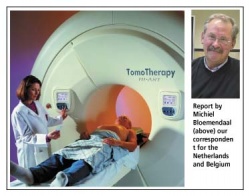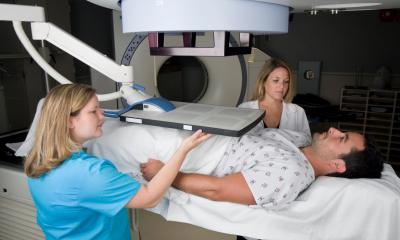Belgian clinic offers TomoTherapy

Brussels - The Radiation Oncology Department at the Vrije Universiteit Brussel has become the first Belgian and second European facility to install the TomoTherapy Hi-Art System, which is the first commercial system specifically designed for IMRT (intensity-modulated radiation therapy). Chosen to complement the department’s oncology treatments the system is expected to reduce side effects (e.g. dry mouth in neck cancer) without compromising a cure.
The TomoTherapy Hi-Art System, which fuses a computed tomography (CT) imaging system with a dedicated system for helical tomotherapy, or slice therapy, combines treatment planning, patient positioning and treatment delivery in precise treatment doses - to all body parts - without increasing radiation deposited on healthy tissue.
Planning - Before beginning this treatment, the doctor uses 3D images (e.g. CT) and special software to establish precise contours for each region of interest (tumour) and any regions at risk (sensitive organs or structures). A decision is then made about the amount of radiation to be given to the tumour, and acceptable levels for surrounding structures are defined. Then the TomoTherapy Hi-Art System calculates the appropriate pattern, position and intensity of the radiation beam to be delivered, to match the doctor’s prescription as closely as possible.
Patient Positioning - A special CT scan can be made just prior to each treatment, so the tumour’s position can be verified and the patient’s position adjusted if necessary (between treatments a patient’s tumour can move).
Helical Treatment Delivery - The TomoTherapy Hi-Art System combines IMRT with a helical (or spiral) pattern to deliver radiation treatment. Photon radiation is produced by a linear accelerator (or linac), which travels in multiple circles all the way around the gantry ring. Meanwhile, the couch also moves, guiding the patient slowly through the centre of the ring, so each time the linac comes around, it directs the beam at a slightly different plane.
03.08.2006











